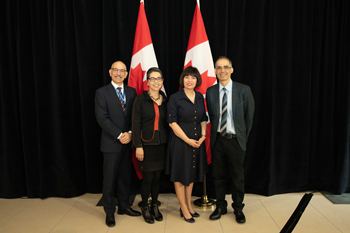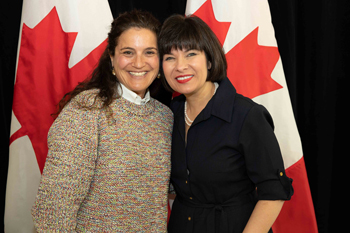Three research teams at St. Michael’s to receive federal funding to address the opioid crisis

By Anna Wassermann

Dr. Ori Rotstein, Dr. Pat O’Campo, Federal Health Minister Ginette Petitpas Taylor and Dr. Tony Antoniou
Federal Health Minister Ginette Petitpas Taylor was at St. Michael’s Hospital on Wednesday morning to announce $10.7 million in funding to support a number of new initiatives focused on addressing Canada’s opioid crisis.
The funding, which is provided by the Substance Use and Addictions Program, the Harm Reduction Fund and the Canadian Institutes of Health Research, will be distributed among 33 initiatives across the country, including three led by researchers at St. Michael’s.
Drs. Tara Gomes and Tony Antoniou, Drs. Michelle Firestone and Ahmed Bayoumi, scientists at the Li Ka Shing Knowledge Institute will be leading the three teams.
“We’re particularly excited about the opportunity to [receive] this specialized funding,” says Dr. Antoniou, whose research with Dr. Gomes, as well as the other two projects, is outlined below. “We’ll look forward to sharing our research and our results when the project wraps up.”
Petitpas Taylor also announced two new treatment options to help health care professionals treat severe opioid use disorder in adults. Health Canada has approved the use of injectable hydromorphone, an opioid used to treat pain, as well as diacetylmorphine, which can now be imported anywhere in the country.
The Ontario Naloxone Program for Pharmacies (ONPP) – Led by Drs. Tara Gomes and Tony Antoniou
The majority of opioid-related deaths are preventable with naloxone, a safe and effective treatment that works quickly to reverse opioid overdose.
In 2016, the Ontario Ministry of Health and Long-Term Care created the Ontario Naloxone Program for Pharmacies, allowing pharmacists to provide take-home naloxone at no charge to individuals at high risk of overdose or death.
Using Ontario’s health record databases, Drs. Gomes and Antoniou, scientists at the Li Ka Shing Knowledge Institute and ICES, and members of their team will be studying how successful the program has been in providing naloxone to eligible individuals. They’ll also be looking at how the program differs among different groups of people who take opioids, and whether the program is having a measurable effect on reducing opioid-related deaths in Ontario.
Evaluation of Overdose Prevention Sites (OPS) in Toronto – Led by Dr. Michelle Firestone

Dr. Michelle Firestone and Federal Health Minister Ginette Petitpas Taylor
Overdose prevention sites provide a safe space for people to use drugs under the supervision of trained staff who can respond in the event of a medical emergency. To date, four overdose prevention sites in Toronto have demonstrated a high volume of use and a significant and positive impact in the community.
Dr. Firestone, scientist at the MAP Centre for Urban Health Solutions of the Li Ka Shing Knowledge Institute, and her team are looking to identify the effectiveness of these overdose prevention sites as a public health response to the current opioid overdose crisis. In particular, they’ll be measuring how various sites in Toronto meet the needs of diverse populations, and assessing current program and service barriers impacting these groups.
Analysis of Spatial and Temporal Relationships in Ontario for Supervised Consumption and Overdose Prevention Evaluation (ASTROSCOPE) – Led by Dr. Ahmed Bayoumi
Supervised injection sites provide a hygienic environment for people to inject drugs under the supervision for trained staff.
In the midst of changes to supervised injection sites across the province, Dr. Bayoumi, , scientist at the MAP Centre for Urban Health Solutions of the Li Ka Shing Knowledge Institute, and his team are examining the effects of implementing supervised injection or overdose prevention services on the number of overdoses that occur in the neighbourhoods where sites are established. They plan to examine changing effects over time, such as drug composition, as well as the effects that supervised injection sites may have on overdoses in adjoining neighbourhoods.
About St. Michael’s Hospital
St. Michael’s Hospital provides compassionate care to all who enter its doors. The hospital also provides outstanding medical education to future health care professionals in more than 27 academic disciplines. Critical care and trauma, heart disease, neurosurgery, diabetes, cancer care, care of the homeless and global health are among the Hospital’s recognized areas of expertise. Through the Keenan Research Centre and the Li Ka Shing International Healthcare Education Centre, which make up the Li Ka Shing Knowledge Institute, research and education at St. Michael’s Hospital are recognized and make an impact around the world. Founded in 1892, the hospital is fully affiliated with the University of Toronto.
About Unity Health Toronto
Unity Health Toronto, comprised of Providence Healthcare, St. Joseph’s Health Centre and St. Michael’s Hospital, works to advance the health of everyone in our urban communities and beyond. Our health network serves patients, residents and clients across the full spectrum of care, spanning primary care, secondary community care, tertiary and quaternary care services to post-acute through rehabilitation, palliative care and long-term care, while investing in world-class research and education. For more information, visit www.unityhealth.to.
